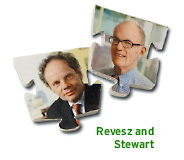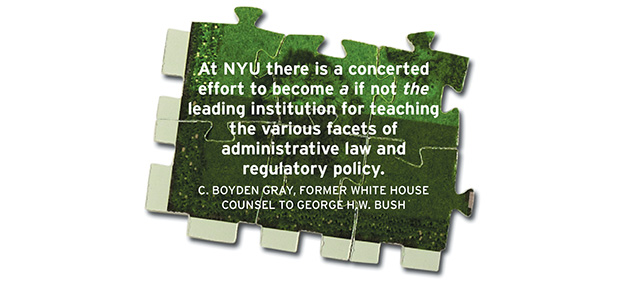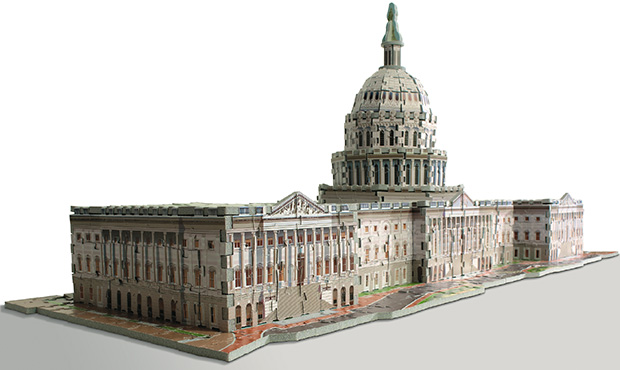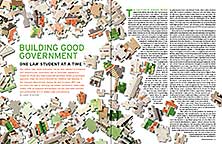Building Good Government
Our nation runs, more and more, not on laws created in Congress and shaped in the courtroom, but on rules and regulations forged by those who hold unelected positions within government agencies, from the Administration for Children and Families to the Treasury Department. During the last 10 years, NYU Law has taken the lead in tailoring law school curricula to reflect this reality, with an engaged and dynamic faculty that both analyzes and participates in U.S. politics and policymaking.
Printer Friendly VersionThe election of Barack Obama reignited the debate about the role of government in regulating the lives of its citizens. The political left welcomed more oversight—and got it with sweeping healthcare reform and financial regulation; the right decried it. But the debate was really over a matter of degree. Starting with the New Deal, the regulatory state has grown into an elaborate system of administrative agencies interpreting and implementing laws passed by Congress. For lawyers, that growth has meant a huge shift in their practices and thinking—from a regime based on judge-made common law to one where government agencies created more and more of the law through regulations. “The modern regulatory state that grew up over the course of the 20th century has completely redefined the nature of law and legal practice,” says Michael Herz, a Benjamin N. Cardozo School of Law professor who is vice chair of the American Bar Association’s section on administrative law and regulatory practice. “Very few lawyers appear in court, but they do deal with agencies.”
Problem was, most law schools failed in their attempts to reflect this fundamental shift. But a decade ago, with the strong support of Professor Richard Revesz, the NYU School of Law put in motion an ambitious plan to prepare students for this new world—and to give them the underpinnings to help build a government that works better. Now the school’s dean, Revesz wanted to have the Law School play a pivotal role in generating fresh ideas in regulation—theoretical and practical—that would be advocated to policymakers here and abroad. Today, after a series of initiatives, the school is considered a leading and innovative center for the teaching and study of administrative law and policy. Its faculty and former students are influential on important regulatory and administrative issues in Washington, from climate change to workplace safety to national security to financial regulation. “NYU has embraced administrative law more fundamentally than any place I know,” says Michael Levine, a distinguished research scholar and senior lecturer at NYU Law and a pioneer in airline deregulation.
Those initiatives have included: 1. In 2003 the school began requiring first-year students to take an administrative and regulatory law course—a closely watched and controversial decision that was soon followed by Harvard and Vanderbilt law schools, with a handful of others, including the University of Michigan and Georgetown, making it a first-year elective. 2. Two years ago, Revesz and one of his former students, Michael Livermore ’06, founded the Institute for Policy Integrity, which advocates before agencies, legislatures, and courts the idea of using cost-benefit analysis and economics to make better regulatory policy. 3. This fall upper-level students began working in a new policy clinic, co-taught by Livermore and Revesz, where they are participating in real regulatory proceedings before federal agencies. And, 4. To create an academic home where scholars and policymakers could wrap their heads around the vexing issue of how agencies, states, and regulators can coordinate across borders and between and among governments, Professors Richard Stewart and Benedict Kingsbury started the Global Administrative Law Project. Says Revesz: “We’re generating ideas, pushing them into the political process, pushing them before administrative agencies, and pushing them into the courts.”
Revesz has also wooed a number of prominent figures from both ends of the political spectrum who reflect a wide range of professional experience in administrative law and regulatory policy to teach at the Law School (see sidebar on page 16). From the bench come Judge Robert Katzmann of the U.S. Court of Appeals for the Second Circuit and Senior Circuit Judge Harry Edwards of the U.S. Court of Appeals for the District of Columbia Circuit. From the executive branch come C. Boyden Gray and Sally Katzen, major regulatory thinkers for former Presidents George H.W. Bush and Bill Clinton, respectively. And from the private sector comes Levine, a former executive at Continental Airlines, Northwest Airlines, and New York Air. Influential administrative law academics, such as Herz from Cardozo and Jerry Mashaw of Yale Law School, have also taught NYU Law students. “At NYU,” says Gray, “there is a concerted effort to become a if not the leading institution for teaching the various facets of administrative law and regulatory policy.”

That effort has clearly grabbed the attention of students. Take Daniel Deacon ’10, who is now clerking for Judge A. Raymond Randolph of the U.S. Court of Appeals for the District of Columbia Circuit—the court that handles a significant proportion of cases that arise out of federal administrative agency actions. Deacon became interested in administrative law and policy while taking the Administrative and Regulatory State (ARS), the required 1L course, under Stewart. In his second year, he took a course with Katzmann on the administrative process and another with Revesz on environmental law. He later worked as a research assistant for Revesz and wrote a student note that was published in the NYU Law Review in June on whether courts should decline to step in when an agency decides not to use its enforcement powers (the courts should generally not review those non-actions, he argued).
Deacon applauds the school’s emphasis on the statutory side of law: “The type of practice most NYU Law grads will have will involve, at the least, statutes in the background on matters they are working on, whether in big law firms or government.”
And consider Daniel Nudelman ’12, who by the end of his first year was already planning to apply for a seat in the administrative law and policy clinic currently taught by Livermore and Revesz—for his third year. What propelled his interest over the course of one semester was taking ARS with Assistant Professor Samuel Rascoff; attending an all-day symposium organized by students from the Environmental Law Journal and the Environmental Law Society that in part addressed cost-benefit analysis and its alternatives for reviewing regulatory policy; and taking in a lunchtime forum during which Gray and Katzen discussed the executive orders they helped draft that spelled out how regulatory decisions would be weighed. “It’s really cool to be here, because there’s obviously a lot going on in this field,” says Nudelman. The combination of courses and substantive extracurricular events, he says, “got me progressively more interested in that side of the law.”
Seeing the Big Picture
For more than a century, first-year law students such as Nudelman have had to take essentially the same courses—torts, property, contracts, civil procedure. They can thank Christopher Columbus Langdell, the legendary legal educator, for that. He instituted a curriculum at Harvard in the late 19th century that was taken as gospel by just about every law school in the nation. Tradition-laden law schools largely resisted efforts to update the curriculum, except for adding a required constitutional law course here and there.
In the early 1990s, NYU Law’s faculty met to consider a more radical proposal: to require an administrative law course for first-year students. Any time a faculty of a law school gathers to discuss changes in curriculum, you can expect angst and heated debate—and such was the case here. The professors were almost evenly split; the proposal lost by a mere one vote.

Ten years later the faculty took up the issue again, the debate no less fevered. Some professors pressed for adding constitutional law as a requirement, while others suggested adding international law or simply offering more electives. But Stewart, who joined the NYU Law faculty in 1992, argued strongly for a required course in the first year that would focus on statutes and their implementation by administrative agencies. “We live in an administrative, regulatory, bureaucratic state at all levels of government,” he told his faculty colleagues, “and it impacts the lives of all of us.”
Stewart, whom many experts consider the area’s founding academic, specializing in environmental law, had long sought the course. He began teaching administrative and environmental law at Harvard Law School in 1971. Four years later he wrote what Revesz calls the seminal article in the area: “The Reformation of American Administrative Law,” published in the Harvard Law Review. The piece conceived the idea, now accepted wisdom and practice, that people other than those directly affected by a regulation had a right to a hearing before an agency or the courts. Stewart followed that up another four years later with one of the earliest textbooks on the topic, Administrative Law and Regulatory Policy, co-authored with his Harvard faculty colleague, Stephen Breyer, who became a Supreme Court justice in 1994. It is currently in its sixth edition.
Pressing the administrative law and policy course requirement with Revesz at committee meetings, Stewart was well aware that the precedent wasn’t encouraging. Similar 1L administrative law and policy courses had been tried and dropped as a requirement at a handful of other law schools, such as Stanford and the University of Chicago, and most notably at Columbia, where it became an elective in 2002 after some 10 years. But, recalls Stewart, “I thought that it could be done right and could be successful, and if we didn’t try, we’d still be stuck with Langdell’s courses.”
The course, formally called the Administrative and Regulatory State, won out over Constitutional Law and debuted in Spring 2003. Today only a few schools—such as Vanderbilt and Harvard, both of which followed NYU Law’s lead—require a similar course. Columbia Law School Professor Peter Strauss, who fought unsuccessfully to retain his school’s required administrative law course, remains a strong advocate. “A curriculum that spends a whole year focusing student attention on common-law courts,” he says, “is misrepresenting what the legal system is about. This course teaches a set of skills lawyers need to have.” Seconds Judge Edwards: “Administrative law and the regulatory state are so prominent now in our system of government that the student ought to begin to understand that sooner rather than later.”
Sorting the Pieces
Seven years later, ARS remains a vibrant offering at NYU Law. Why has it succeeded here? For one thing, Stewart and Revesz determined early on that a particularly adept set of teachers, interested in public law and regulation, was needed to teach a class that doesn’t look or feel like the other common law–based 1L classes. “It’s not an easy course, because in tort law, criminal law, contract law, you have certain substantive principles you can lay out,” Stewart says. “But this is a course about institutions and processes, so it’s more difficult for students to grasp.”
A second reason for the course’s success: Faculty agreed on a core set of principles and cases all would teach. They would refrain from turning it into a mushy, theoretical, political science–like course, the undoing at some other schools. At the heart of the principles was the idea that students would understand how Congress makes statutes and how courts and administrative agencies interpret them. At the same time, the professors would inject their particular interest in certain substantive issues, such as the environment, immigration, and education. That intersection allows them to illustrate administrative law points using cases and insights drawn from their expertise, keeping the course topical.
“Everyone is cooking chicken soup, but everyone adds his or her flavor into the recipe,” is how Professor Rascoff puts it. So Rascoff, an expert on terrorism, flavors his course by exploring how administrative law principles can be applied to national security issues. Cristina Rodríguez, who also taught the class at Harvard in Spring 2010 as a visiting professor, stirs in immigration cases. Rachel Barkow, a telecommunications lawyer before joining the faculty, sometimes seasons her course with a Federal Communications Commission case study. Stewart, Roderick Hills Jr., and Brookes Billman (LL.M. ’75) pepper theirs with environmental cases, Title IX education issues, and tax examples, respectively. “Given who they have teaching it,” says Herz, “if the course can’t succeed at NYU, it can’t succeed anywhere.”
[Sidebar: Building on the Foundation]

The professors’ differing specialties and perspectives provide students with a rich and nuanced understanding of how our government truly works. Consider how Barkow and Rodríguez teach the fundamental issue of delegation, the question of how and when Congress can delegate power to executive agencies. Barkow uses the 1935 Supreme Court decision known as Schechter Poultry to mark what she calls the high point of the idea that Congress had little power to delegate. In that case the court struck down New Deal regulations governing chicken safety and worker wages. Oft cited is the remark Justice Louis Brandeis made to an aide to FDR: “This is the end of this business of centralization, and I want you to go back and tell the president that we’re not going to let this government centralize everything.” It was a battle won, however, and not the war. From that point on, Barkow says, citing cases involving regulation of benzene and air quality, among others, it’s largely settled that Congress can delegate just about anything. Even still, the issue does not always sit well, as Rodríguez has shown in her class. She discusses a 2005 law allowing Homeland Security to do whatever it needed to build a border fence, including waiving federal, state, and local laws to override environmental and labor laws. Outraged opponents took the law to the top, but to no avail. In 2008 the Supreme Court, without comment, declined to hear an appeal.
Cost-benefit analysis is another staple of administrative law that gets tweaked differently by various professors. Cost-benefit is the now-routine practice, begun under President Reagan, of regulators weighing whether a proposed rule’s price tag exceeds its advantages.

Barkow discusses in class the notion of using cost-benefit analysis to a greater extent in criminal law. She believes the administration of criminal law should be no different from, say, environmental or securities regulation. A law that sets certain mandatory minimum sentences for drugs, for example, should weigh the cost—in the amount of prison beds, guards, buildings—against the benefits to society, she says. “Cost-benefit analysis doesn’t dictate a solution. But it is a very rational process for thinking about the pluses and minuses as opposed to using sensational anecdotes designed to charge up people’s emotions,” Barkow says, referring to media firestorms about crimes.
And both Barkow and Rascoff expose students to the idea that cost-benefit analysis should be applied to national security policies. Should airport security rules, for example, be subjected to the rigors of cost-benefit analysis? “Is there a role for this kind of ‘on the one hand, on the other’ approach in the national security base?” Rascoff asks in class.
At first, some students think it’s dangerous to take chances with people’s lives. Says Rascoff: “It becomes uncomfortable terrain for people to think there’s a price tag that we’re placing on security, even though it’s just as uncomfortable that we’re placing a price tag on people’s lives when we regulate the economy or regulate safety in the workplace.”
Connecting the Parts
Rascoff has a realworld background in national security. He was director of the New York City Police Department’s 25-person intelligence analysis unit for two years before joining NYU Law’s faculty in 2008. He has embarked on a project, funded by a two-year, $100,000 grant from the Carnegie Foundation in 2009, that attempts to discover how much government officials understand about Islam and how they generate this knowledge. His point is that just as EPA regulators need to understand science, national security personnel need to understand Islam.
Rascoff continues to work on terrorism issues contractually with law enforcement agencies. Now that he’s not managing intelligence agents, though, he says he has time to think and share the “bigger thoughts” with the folks who do security work all day.

In doing this, Rascoff lives up to one of the hallmarks of this group of teachers and scholars: engagement with our government and democracy, starting with Stewart. “Dick Stewart is the model of the publicly engaged academic,” says Herz, who has taught the ARS course at NYU and in Spring 2010 taught the Advanced Administrative Law class. “On the one hand, he has this extraordinary academic career, and on the other, he has been very hands-on in the real world.”
In an effort to reform environmental laws, Stewart co-founded in 2006 an organization called Breaking the Logjam, jointly funded by NYU Law and New York Law School. The logjam refers to the fact that the last major piece of environmental legislation came in 1990, with amendments to the Clean Air Act. “Our federal environmental statutes basically date back to the 1970s,” says Stewart, who heads the group with NYU Law colleague Katrina Wyman and New York Law School professor David Schoenbrod. The organization’s goal is to bridge the gap between the left and right with, Stewart says, “better, smarter ways to regulate.”
Drawing on the views of 40 environmental scholars, the group has issued reports generally advocating market systems for dealing with pollution, including cap and trade for both greenhouse gases and conventional air pollutants. Stewart and Schoenbrod have conducted briefings and workshops with Congress and the administration as well as environmental, industry, and other groups. Stewart is realistic enough to know that today’s raging political divisiveness poses a challenge to enactment of these ideas. But at least, he says, his proposals are getting seeded among important policymakers.
Stewart was also instrumental, along with NYU Law Professor Kingsbury, in starting the Global Administrative Law Project in 2005. Through conferences and papers, the group is exploring whether and how administrative procedures common in the U.S.—such as judicial review, transparency, and participation—can be applied globally. It’s addressing the concern that global regulation, through agencies such as the World Trade Organization or the World Bank, has enormous impact on people on anything from the environment to trade to intellectual property piracy. Yet those agencies are often not subject to the basic administrative procedures that would enhance their legitimacy.
“You get a lot of very important decisions that are made beyond the state without the normal elections or some sort of legal review,” Stewart says. Developing countries in particular, he notes, may not have the resources and wherewithal to effectively participate in regulation making. To strengthen that capability, the GALP has held conferences on the topic in such cities as Buenos Aires, New Delhi, and Cape Town. Judge Katzmann, who teaches an upperlevel seminar on administrative law at NYU, calls the GALP “pathbreaking” in how it created a community of scholars, lawyers, and policymakers around the world to examine administrative law issues. Indeed, Stewart proudly notes that global administrative law has become in effect a trademark in legal literature, as that community recognizes the need for better regulatory policies around the world. GALP plans to issue specific recommendations after its current fact-finding phase.
If Stewart wrote the seminal article on administrative law in 1975, then Revesz might be considered among the second generation of administrative law and policy scholars—and one of the most widely followed, especially on environmental regulation and cost-benefit analysis. On two occasions, in 1994 and 2007 (the latter with a student, Nicholas Bagley ’05), Revesz’s writings have won the American Bar Association’s award for best article published during the previous year in the administrative law area. Only three other scholars have gained that double distinction: Jerry Mashaw, Columbia Law School’s Thomas Merrill, and Harvard Law School’s Cass Sunstein, now the administrator of the Office of Management and Budget’s Office of Information and Regulatory Affairs.
Revesz is notably generous with his time and expertise in mentoring students and academics in the administrative law area. Bagley recalls how Revesz assigned him difficult writing assignments that quickly stretched him. “He’d then look over what you did, sit down with you, and walk through what worked, what didn’t, and what I might do to make the piece stronger,” Bagley says. “Then I’d try again.”
Rascoff, too, praises Revesz for guiding him. In 2001 Revesz offered Rascoff a fellowship at the Frank J. Guarini Center on Environmental and Land Use Law, and the two collaborated closely on a law review article about risk regulation, during which Revesz “constantly pushed me—in his unfailingly gentle way—to deepen my thinking about law and policy,” Rascoff remembers. “He showed me by example what rigorous legal scholarship is all about.”

Revesz’s current outreach into the policy world centers on his work in cost-benefit analysis, an interest that goes back to the Clinton years, when he served on a science advisory board to the Environmental Protection Agency. He recalls how he noticed something odd then: No environmental groups ever showed up to testify about EPA’s guidelines for the preparation of cost-benefit analyses. Yet trade associations representing polluters frequently came to present their views, allowing them far more influence to shape regulations to their liking. Environmentalists were so inherently opposed to weighing costs and benefits of regulations that they absented themselves from the discussions. In their view, it’s wrong to even try to put a dollar value on lives.
Katzen, who headed the Office of Information and Regulatory Affairs in the Clinton administration and will be a visiting professor at NYU School of Law in Spring 2011, also saw this firsthand. “We in the Clinton administration were thinking how to do cost-benefit analysis, and labor, the enviros, and public safety folks were conspicuously absent,” she recalls. “Who came to the table? The people who believe in mathematical precision. Where were the people to talk about how to do it in a more sensible way? They decided not even to participate.”
The frustrating experience convinced Revesz, along with Livermore, then a student, to write a book that challenges the liberal camp to dive into cost-benefit analysis. In their 2008 book, Retaking Rationality: How Cost-Benefit Analysis Can Better Protect the Environment and Our Health, they argue that cost-benefit analysis, when done properly, can in fact thwart anti-regulatory forces and arrive at progressive regulations. “Ricky was not buying into those who are totally enamored of cost-benefit analysis,” Katzen says, “but at the same time, he was not buying into the more liberal wing that says, ‘Why do any analysis?’ He basically says it’s the best information we have, and let’s see if we can make it better.”
To extend these ideas outside academia, Revesz and Livermore founded the Institute for Policy Integrity (IPI), also in 2008, with grants from the Hewlett Foundation and the Rockefeller Family Fund, among others. Staffed by lawyers and economists, IPI publishes studies, files amicus briefs, and meets with NGOs to discuss how they can employ cost-benefit analysis in their areas. Says Katzmann: “To my knowledge, there is no other law school that has brought to the fore in such a focused way this important aspect of decision-making.”
[Sidebar: The Libertarian Among Us]
Early in the Obama administration, the institute offered its suggestions about how to fix the government’s regulatory review process, including the cost-benefit component, essentially left over from the Clinton era. The institute has devoted considerable time to climate change, releasing a study in 2009 that looks at the way the EPA can regulate greenhouse gases under its existing authority and discussing the design of attractive cap-and-trade schemes. And it has weighed in on such disparate issues as the controversy affecting control of Internet content known as Net neutrality, the hazards of mountaintop mining, and the number of hours a trucker can safely drive.
The institute is also trying to spread its cost-benefit gospel to developing countries, holding conferences in Chile, the Dominican Republic, and China. In such little-regulated countries, new environmental regulation would bring massive benefits compared to its cost.
Richard Pildes, Sudler Family Professor of Constitutional Law, is another example of a faculty member heavily engaged in the real world—or, as Revesz puts it, proof that “we’re not just writing articles nobody reads.” He notes that Pildes has played a role in several of the most important administrative law issues to come before the Supreme Court during the last 10 years.

The most significant was the attack on the constitutionality of the Sarbanes-Oxley law, enacted in 2002 after the financial crisis brought on by the Enron debacle. Plaintiffs argued that the regulatory board created by the law to police the accounting profession was too independent of the president (he had no authority to remove members) and thus unconstitutional under the separation of powers doctrine. Pildes, representing seven former chairmen of the Securities and Exchange Commission, including Harvey Pitt and Arthur Levitt, filed amicus briefs supporting the law—from the trial court up to the Supreme Court, over a period of several years. His argument: The disputed agency (the Public Company Accounting Oversight Board) was completely under the control of the SEC. So, “[a]s long as the SEC itself is constitutional, the SECBoard structure is constitutional,” Pildes stated in his 2009 brief. In a June decision that delighted Pildes, the court rejected all the constitutional attacks, save one minor defect, leaving the accounting board in place. In a separate opinion, Justice Breyer cited both Pildes’s amicus brief and an article on the SEC-Board structure that he published in 2009 in the Vanderbilt Law Review En Banc.
“It’s the kind of issue,” Pildes says, “that goes to the heart of the relationship between the Constitution and the structure of administrative governance—exactly the kinds of things we teach in the first-year course.” Pildes and other professors have used the case itself in class; Barkow even used it as an exam question one year. Indeed, Pildes adds bemusedly, the facts of the case are so germane that “one could imagine making it up to help students sharpen up their understanding of the various issues.”
In another high-profile Supreme Court case, in 2005, Pildes won in a decision that divided the Court 7 to 2 and sharply rebuked the U.S. Tax Court for concealing documents and findings from people with cases before the court. The broader issues addressed questions of the institutional structure of the Tax Court and how it conducted trials. Pildes recalls that during the appellate stage, the judge, an administrative law expert, grilled him about the “classic” administrative law cases from the 1940s and ’50s that are always taught in the ARS class.
Pildes is currently involved in another potential Supreme Court case that raises the administrative law issues of due process and fair treatment. Along with Paul Clement, a former U.S. solicitor general and adjunct professor at NYU Law, he is representing a health insurer in a dispute with a Puerto Rican taxing authority.
The ascension of the Obama administration, along with the reality check of the financial crisis, brought a new focus to the role of government regulation—creating opportunities for NYU professors to influence the debate. Barkow was asked, for example, to weigh in on Obama’s plan to create a Consumer Financial Protection Agency to oversee financial instruments such as mortgages and credit cards, part of the proposed overhaul of the nation’s financial regulation system. Given that she specializes in criminal law, and not in business or corporate law, the invitation was a testament to her insights into administrative design. Testifying in July 2009 before a House subcommittee, she urged a series of changes in the legislation that generally would make it more independent of the president and less dominated by any one political party. She urged that no more than three of the five members of the agency hail from the same political party. The addition of different political viewpoints, she said, will temper the common tendency of likeminded people to adopt extreme positions.
In the spring, Barkow was named to a panel that will advise the Manhattan district attorney’s office on how to avoid wrongful convictions. The assignment is a species of administrative law, she notes, and in fact fits nicely into the longtime focus of her scholarship: how the theories and practices of administrative law can be applied to the criminal justice system, from sentencing to prosecutors’ offices.
Consider the question of how to police federal prosecutors, a topic Barkow explores in a February 2009 Stanford Law Review article, among other papers she has published on this topic. Prosecutors represent, she writes, a “glaring and dangerous exception” to the separation-of-powers idea. Immensely powerful, they can both advocate decisions and make final adjudications (95 percent of all federal cases are settled in nontrial pleas). As she points out, “There are currently no effective legal checks in place to police the manner in which prosecutors exercise their discretion to bring charges, to negotiate new pleas, or to set their office policies.”
How to prevent abuses? Barkow notes in her article that lawmakers are reluctant to rein in prosecutors for fear of looking soft on crime. So she proposes using an administrative model of checks and balances because, after all, prosecutors are effectively regulators. Think about how they often strong-arm corporate executives into agreeing to deals rather than have their companies face potentially crippling criminal charges. “If I say I’m going to charge you unless you do the following things—change your business, install a monitor—this looks a lot like regulation,” she says, describing the main thrust of her article. (In 2009, “Regulation by Prosecutors” was the inaugural symposium of the Center on the Administration of Criminal Law, where Barkow is faculty director. Key participants included Mary Jo White, former U.S. attorney for the Southern District of New York, and James Comey, former U.S. deputy attorney general under John Ashcroft and Alberto Gonzales.) The safeguard she advocates, borrowed from administrative policy, is to separate the individuals who carry out the investigation from those who decide whether to file charges, to avoid the appearance and reality of bias. This would work better, she says, than other politically difficult ideas often discussed, such as judicial review or a limit on plea bargains. She argues that her approach should appeal to prosecutors, as it keeps decision-making within their offices.
In a paper published in the Yale Law Journal in December 2009, Rodríguez also weighs in on the separation-of-powers issue, but by looking at the issues through an immigration lens. With her co-author, Adam Cox, a University of Chicago Law School professor, she argues that although the president has power over whom to deport, the chief executive is lacking authority on whom to admit; Congress has that responsibility. That is illogical as well as slow. “We need to change the way we think about how to admit immigrants, especially immigrant workers,” she says. “The current system is too sclerotic, too slow to react, not responsive to conditions in the world.”
At the Migration Policy Institute, a Washington, D.C., think tank where she is a nonresident fellow, Rodríguez works on the controversial issue of who should enforce immigration law—local police or federal authorities. One key question she’s studying is how the Department of Homeland Security can maintain authority over state and local officials who have, in some high-profile cases, relied on racial profiling.
 Topping Off
Topping Off
You can make the argument that Craig Wenner, who will graduate from NYU Law in Spring 2011, has already won his first administrative law case. Working over the summer after his 1L year for Revesz and the Institute for Policy Integrity, Wenner helped research and write an amicus brief using cost-benefit analysis to attack a Bush administration rule setting trucker driving hours. The regulation was ultimately withdrawn by the Obama administration, leading to the dismissal of the case. Though victorious, Wenner would have liked to see how his legal arguments would have stood up in court.
Like other students, Wenner expresses some amazement that administrative law wasn’t required in years past. “The regulatory state is one of the few aspects of law that really touches individuals on an everyday basis,” he says. “And the day-to-day practice of lawyers generally always involves government agencies to some degree.” Nicholas Bagley, who was in that first-ever ARS class in 2003, worked from 2007 to 2010 at the Department of Justice. Almost every day, he says, he harked back to the lessons learned from Richard Pildes when he dealt with cases involving federal agencies such as the Federal Aviation Administration and the Federal Bureau of Investigation. “Administrative regulation is pervasive,” he says. And lawyers practicing in the private sector are no different in their need to understand the subject, asserts Bagley. In a nod to Langdell’s time, Bagley says: “I think it’s a difficult argument to sustain nowadays that property—to name just one of the tried-and-true courses—is more fundamental to the work of a lawyer than administrative law.”
One of the Law School’s most recent graduates underscores this point. At the White House, David Kamin ’09 is special assistant to the president on economic policy at the National Economic Council. But from 2009 to 2010 he was adviser to Peter Orszag, director of the Office of Management and Budget. In that role, he was a policy guy on budget matters without an explicitly legal role—yet administrative law issues were never far from his job. His ARS course and advanced administrative law class with Rachel Barkow proved “incredibly helpful.” When, for instance, Obama proposed a regulatory body like a Medicare Commission, Kamin had a knowledge base that at least allowed him to understand the discussions. “As you develop a proposal, it’s very helpful to know the ways that regulations get formed, the ways regulations get litigated,” he says. “If someone says this is a delegation issue, you understand what they are talking about.”
Kamin pays the ultimate student compliment to his teacher when talking about meetings in which an administrative law issue arose: “I’ve often thought of writing to Professor Barkow and saying, ‘You know, I’m damned glad I took your class!’”
Larry Reibstein is an editor at Forbes Media.
—
All 2010 Features



 Multimedia
Multimedia